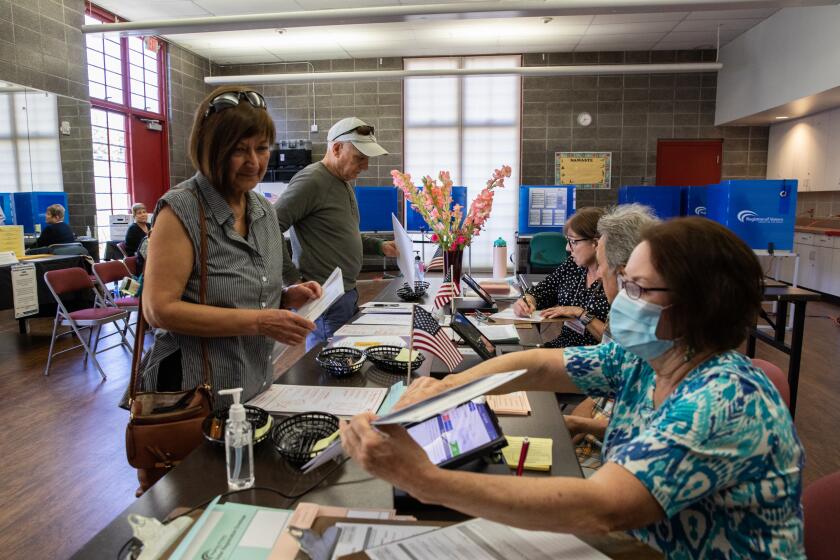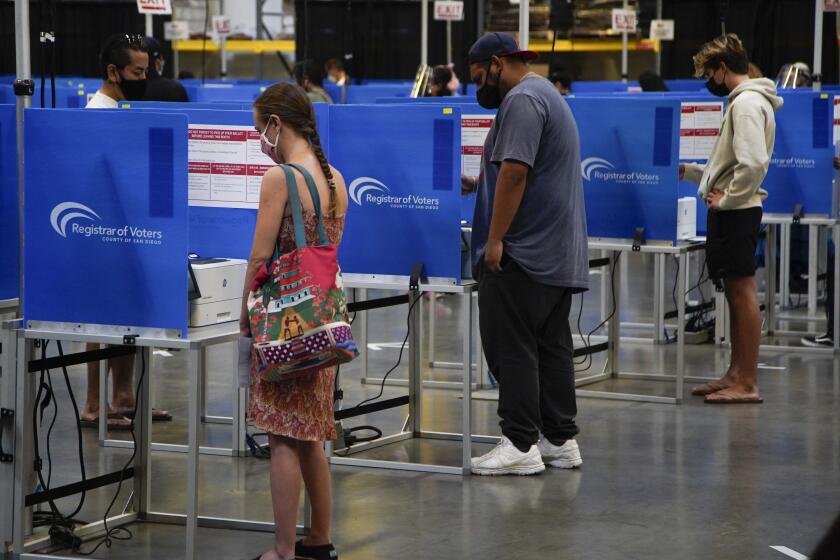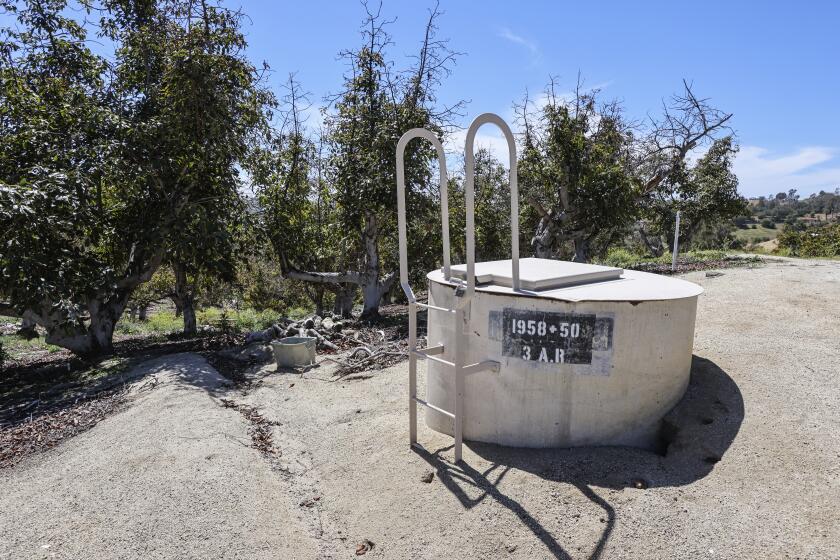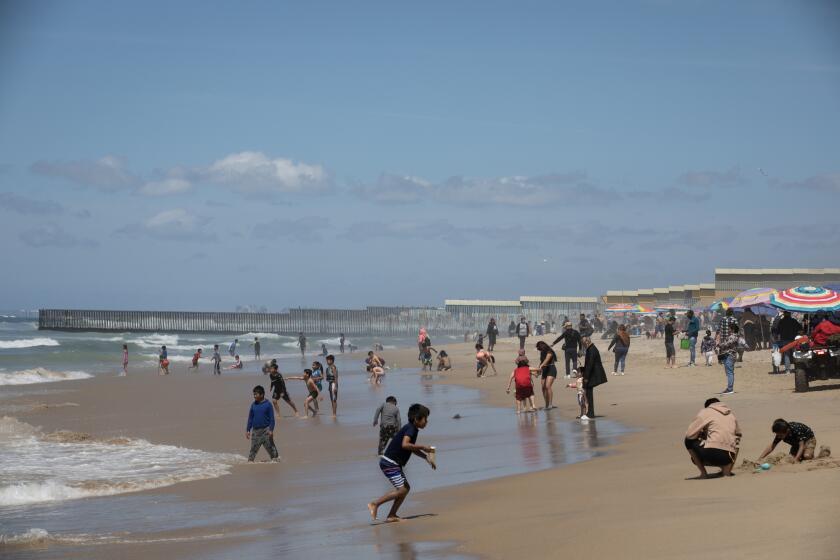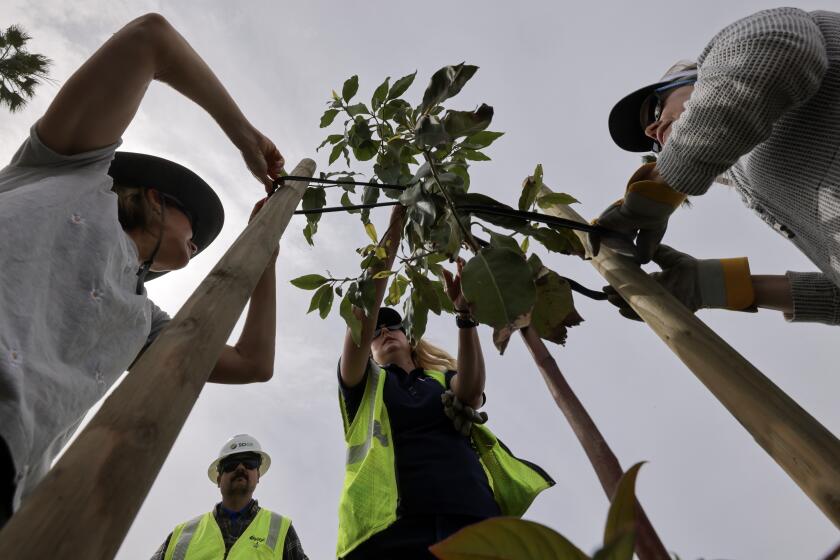Turning water shortage into wine
After half a century of farming, Valley Center rancher Gary Broomell is watching citrus groves he planted wither away, defeated by drought and time.
“A lot of these trees are 50, 54 years old,” said Broomell, owner of Triple B Ranches. “And some of them are getting tired. Just like me.”
The citrus and avocado farms that bloomed in San Diego County flourished on inexpensive water for decades. After two back-to-back droughts during the past decade, however, scarcer and costlier water has led farmers such as Broomell to shut off irrigation to groves.
Parched and abandoned orchards mark the backcountry. Acres of avocados are slashed to stumps. Beneath that gloomy landscape, however, are seeds of perseverance and innovation that could yield new harvests for the region’s farms.
“It’s a huge transition,” said Gary Arant, general manager of the Valley Center Municipal Water District, citing the emergence of lower-water crops such as wine grapes. “They are evolving. Eventually, I think Valley Center will be a huge wine center.”
In the meantime, the county’s annual crop report paints a mixed picture.
The 2012 report, released last year, marked a growth in the dollar yield of San Diego crops — from $1.55 billion in 2008 to almost $1.75 billion in 2012. However, agricultural acreage declined for most of those years before experiencing a 1 percent uptick in 2012.
The 2013 report is due to be released in coming weeks.
Agricultural water use in the county fell by more than half between 2007 and 2013, according to numbers from the San Diego County Water Authority.
Growers typically receive discounted water rates in exchange for less certain supplies. But in Valley Center, those rates more than doubled — from $490 to $1,314 per acre-foot — over the past decade. An acre-foot is the amount of water needed to cover an acre a foot deep, or about enough to supply two homes for a year.
During that time, water sales to farms supplied by the Valley Center district dropped by more than half, from about 40,000 acre-feet per year to less than 20,000. And the number of agricultural customers in that area dropped from about 1,850 in 2007 to 1,111 today, Arant said.
Other agricultural districts are seeing similar drops in water sales.
In the Rainbow Municipal Water District, total water use has declined by at least a third during the past five to seven years, from more than 30,000 acre-feet to roughly 20,000, said interim general manager Chuck Sneed. That’s mostly due to declining agricultural activity as farmers’ water rates climbed to $1,233 per acre-foot.
The Rainbow district has extended statewide limits on watering times to cover agricultural as well as domestic customers, Sneed said, so avocado growers must water overnight instead of during the day.
For the Fallbrook Public Utilities District, total water sales have fallen from about 17,000 to 11,000 acre-feet since 2007, with farm water prices now at $1,023 per acre-foot, said general manager Brian Brady.
Improvements in water efficiency account for part of the reduced consumption, but declines in cultivation also play a role.
“There are three ways farmers are going,” Arant said. “They are shutting off meters and letting trees die. They’re trying to find ways to farm with less water. Or they’re farming higher value crops.”
In some cases they’ve abandoned farming all together. A 500-acre grove of dying citrus trees was slated for a housing subdivision in Valley Center, but remains shriveled and neglected years later. Other growers have switched to solar farms, replacing orchards with rows of shiny silver panels.
Where farming continues, growers are adapting. Some are planting avocado trees closer together to economize water use in groves, said Bob Lucy, co-owner of Del Rey Avocado in Fallbrook and a board member of the Rainbow Municipal Water District. They’re also replacing older trees with new avocado varieties that can withstand higher salt levels, to compensate for reduced well-water quality caused by the drought, Lucy said.
Other growers are replanting land with organic vegetables and drought-tolerant fruits and vineyards.
“The diversification makes sense,” said Eric Larson, executive director of the San Diego County Farm Bureau. “If you only grow one product, you’re going to live or die by that product. So for them the strategy is diversification, and being able to move rapidly from one crop to another.”
Valencia oranges are the mainstay at Triple B Ranches, but five wells have dried up during three years of recent drought. The Broomells have bought water to supplement the wells, but in some cases the costs and income don’t add up, so they’ve pushed out the trees.
“I’m nervous and kind of sad because I think if we don’t get that rain, we haven’t seen the worst,” said Debbie Broomell, 52, whose father, Gary, founded the ranch in 1959.
The family has adjusted by planting some of its land with dry farmed crops, vegetables and, most importantly, vineyards. And it launched its Estate Winery and tasting room, where varieties such as merlot, syrah, cabernet sauvignon and viognier are produced and sold.
Debbie’s son Chris Broomell learned winemaking in Santa Barbara and Australia, but credits his interest in the trade to his San Diego roots.
“I guess the reason I’m making wine in San Diego is to try to keep farming around,” said Broomell, 30. “It’s a really fun time for it right now. There’s quite a bit of growth and experimentation.”
The Broomells have 13 acres planted with wine grapes, but Chris Broomell looks forward to eventually tripling that. The plan is to produce wines in larger batches and supply other wineries in the region.
Chris Broomell has tested dry-farming techniques; despite record-low rainfall, he’s growing some vines with no irrigation whatsoever. And he’s experimenting with new varieties, such at the light-skinned vermentino grape, which hails from the ultra-dry island of Sardinia.
“I know there are certain areas where farmers are taking out citrus or avocados and planting grapes because of the water shortage,” he said. “The drought situation is probably helping the wine industry grow. People are looking at it more seriously as an option.”
At nearby Stehly Farms Organics, third-generation farmers Noel and Jerome Stehly converted from conventional avocado orchards to diverse organic crops about a decade ago, inspired by their own young families.
“It was a philosophical thing,” said Noel Stehly, 45. “We saw the health benefits of organics.”
At the same time, he said, organic avocados fetched a higher price at market than conventionally grown crops, increasing their profit per acre. Their Valley Center ranch now yields a cornucopia of berries, vegetables, year-round avocados, exotic citrus and dragonfruit, an Asian delicacy that comes from a cactus plant.
The family also sells directly to consumers through its own line of San Diego retail stores, farmers markets and community-supported agriculture programs that offer pre-packed produce boxes.
Retail sales allow growers to capture a larger share of profits. And recent interest in locally grown, “farm to table” food boosts demand for their wares, said Stehly sales manager Jared Bray.
For Chris Broomell, meeting customers is one of the rewards of farming.
“Growing up I’d watch my grandfather, and he loves growing citrus,” Broomell said. “He still does, and probably has a hard time letting go of it. But you never really get to see anyone enjoy it.”
By contrast, he said, the winery allows him to view the fruits of his labor.
“Watching someone drink wine with a smile on their face and engage you about the wine and how you made it, it gives you a little more fuel to try and do better,” he said.
Although his grandfather Gary grieves the loss of citrus orchards, the younger Broomell sees the budding vineyards as the restoration of an even older tradition.
“In San Diego County, there was this huge vineyard industry prior to Prohibition and the water project,” Chris Broomell said. “So for me, it’s basically like we were going back to what we were. So that could be nostalgia.”
Get Essential San Diego, weekday mornings
Get top headlines from the Union-Tribune in your inbox weekday mornings, including top news, local, sports, business, entertainment and opinion.
You may occasionally receive promotional content from the San Diego Union-Tribune.

